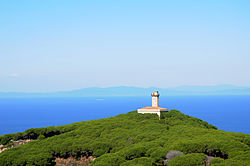Giglio Island
| Isola del Giglio | |
|---|---|
| Comune | |
| Comune di Isola del Giglio | |

Old Lighthouse on the north of the island
|
|
| Location of Isola del Giglio in Italy | |
| Coordinates: 42°21′N 10°54′E / 42.350°N 10.900°ECoordinates: 42°21′N 10°54′E / 42.350°N 10.900°E | |
| Country | Italy |
| Region | Tuscany |
| Province / Metropolitan city | Grosseto (GR) |
| Frazioni | Isola di Giannutri, Giglio Castello, Giglio Porto, Giglio Campese |
| Government | |
| • Mayor | Sergio Ortelli (since June 2009) |
| Area | |
| • Total | 23.80 km2 (9.19 sq mi) |
| Elevation | 405 m (1,329 ft) |
| Population (1 January 2015) | |
| • Total | 1,447 |
| • Density | 61/km2 (160/sq mi) |
| Demonym(s) | Gigliesi |
| Time zone | CET (UTC+1) |
| • Summer (DST) | CEST (UTC+2) |
| Postal code | 58010, 58012, 58013 |
| Dialing code | 0564 |
| Patron saint | San Mamiliano |
| Saint day | September 15 |
| Website | Official website |
Isola del Giglio (Italian pronunciation: [ˈiːzola del ˈdʒiʎːo]; English: Giglio Island) is an Italian island and comune situated in the Tyrrhenian Sea, off the coast of Tuscany, and is part of the Province of Grosseto. The island is one of seven that form the Tuscan Archipelago, lying within the Arcipelago Toscano National Park. Giglio means "lily" in Italian, and though the name would appear consistent with the insignia of Medici Florence, it derives from Aegilium, "Goat Island", a Latin transliteration of the Greek word for "little goat" (Ancient greek: Aigýllion, Αιγύλλιον).
The island is separated by a 16-kilometre (10 mi) stretch of sea from the nearest point of the mainland, the promontory of Monte Argentario. Mainly mountainous, it consists almost entirely of granite, culminating in the Poggio della Pagana, which rises to 496 metres (1,627 ft). Ninety percent of its surface is covered by Mediterranean vegetation, alternating with large pine forests and numerous vineyards which allow the production of the local "Ansonaco" wine. The coast is 27 kilometres (17 mi) long, made up of rocks, smooth cliffs and several bays: Arenella, Cannelle, Caldane and Campese, the biggest one with its small village of the same name.
The municipality is composed of the islands of Giglio and Giannutri. Three principal settlements are located on the main island:
The modern island was formed probably 4.5 to 5 million years ago, and has been inhabited since the Stone Age. Later, it was probably an Etruscan military stronghold. Under the Roman dominion, Aegilium Insula or Igillia Insula it was an important base in the Tyrrhenian Sea, and was cited briefly by Julius Caesar in his De Bello Civili, by Pliny, by Pomponius Mela, and by the fifth-century AD poet Rutilius Claudius Namatianus, who celebrated Igilium's successful repulse of the Getae and safe harbor for Romans, in a time when Igilium's slopes were still wooded:
...
Wikipedia

